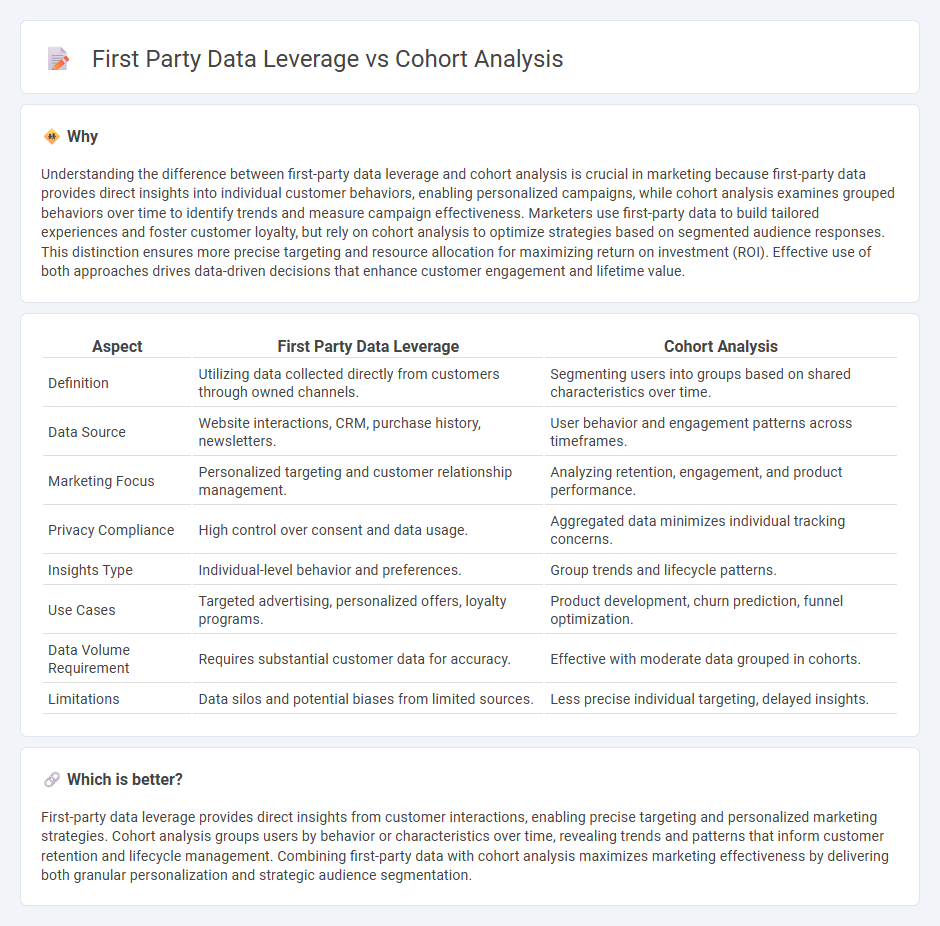
First-party data offers precise insights by collecting information directly from customers, enabling highly personalized marketing strategies. Cohort analysis segments users based on shared characteristics or behaviors over specific time frames, uncovering trends that drive targeted campaigns. Explore how leveraging both methods can optimize your marketing performance and customer engagement.
Why it is important
Understanding the difference between first-party data leverage and cohort analysis is crucial in marketing because first-party data provides direct insights into individual customer behaviors, enabling personalized campaigns, while cohort analysis examines grouped behaviors over time to identify trends and measure campaign effectiveness. Marketers use first-party data to build tailored experiences and foster customer loyalty, but rely on cohort analysis to optimize strategies based on segmented audience responses. This distinction ensures more precise targeting and resource allocation for maximizing return on investment (ROI). Effective use of both approaches drives data-driven decisions that enhance customer engagement and lifetime value.
Comparison Table
| Aspect | First Party Data Leverage | Cohort Analysis |
|---|---|---|
| Definition | Utilizing data collected directly from customers through owned channels. | Segmenting users into groups based on shared characteristics over time. |
| Data Source | Website interactions, CRM, purchase history, newsletters. | User behavior and engagement patterns across timeframes. |
| Marketing Focus | Personalized targeting and customer relationship management. | Analyzing retention, engagement, and product performance. |
| Privacy Compliance | High control over consent and data usage. | Aggregated data minimizes individual tracking concerns. |
| Insights Type | Individual-level behavior and preferences. | Group trends and lifecycle patterns. |
| Use Cases | Targeted advertising, personalized offers, loyalty programs. | Product development, churn prediction, funnel optimization. |
| Data Volume Requirement | Requires substantial customer data for accuracy. | Effective with moderate data grouped in cohorts. |
| Limitations | Data silos and potential biases from limited sources. | Less precise individual targeting, delayed insights. |
Which is better?
First-party data leverage provides direct insights from customer interactions, enabling precise targeting and personalized marketing strategies. Cohort analysis groups users by behavior or characteristics over time, revealing trends and patterns that inform customer retention and lifecycle management. Combining first-party data with cohort analysis maximizes marketing effectiveness by delivering both granular personalization and strategic audience segmentation.
Connection
First-party data provides accurate, privacy-compliant insights directly from customers, serving as the foundation for effective cohort analysis in marketing. By segmenting audiences into distinct cohorts based on behavior and characteristics derived from first-party data, brands can tailor personalized marketing strategies that enhance customer engagement and lifetime value. Leveraging this connection optimizes targeted campaigns, improves retention rates, and drives data-driven decision-making.
Key Terms
Segmentation
Cohort analysis segments users based on shared characteristics or behaviors over time, enabling precise tracking of retention and engagement trends within defined groups. First-party data leverage enhances segmentation by utilizing directly collected customer information to create highly personalized marketing strategies and improve targeting accuracy. Explore the distinct advantages of employing cohort analysis alongside first-party data for superior segmentation insights.
Attribution
Cohort analysis enhances attribution by grouping users based on shared characteristics and tracking their behavior over time, enabling precise measurement of marketing impact on specific segments. First-party data leverage improves attribution accuracy by utilizing direct customer insights collected from owned channels, reducing reliance on third-party cookies and increasing data privacy compliance. Explore the benefits of combining cohort analysis with first-party data for a comprehensive attribution strategy.
Personalization
Cohort analysis segments users based on shared characteristics or behaviors over time, enabling brands to tailor personalization strategies effectively by understanding user journeys and retention patterns. First-party data leverage involves collecting direct customer data from interactions, facilitating highly accurate and privacy-compliant personalization experiences. Explore how integrating cohort analysis with first-party data can revolutionize your personalization efforts.
Source and External Links
Cohort Analysis - Cohort analysis is a form of behavioral analytics that groups data into related cohorts for analysis, helping businesses address specific questions and improve strategies.
What is Cohort Analysis? Strategies to Boost Retention - This article provides a structured approach to conducting cohort analysis for understanding user behavior and boosting retention.
Cohort Analysis - Definition, and How To Conduct One - Cohort analysis helps businesses understand customer behavior across lifecycles by grouping data into actionable cohorts, enabling targeted marketing strategies.
 dowidth.com
dowidth.com